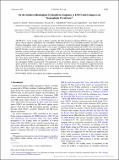On the Southern Hemisphere Stratospheric Response to ENSO and Its Impacts on Tropospheric Circulation
Author(s)
Stone, Kane A; Solomon, Susan; Thompson, David WJ; Kinnison, Douglas E; Fyfe, John C
DownloadPublished version (6.713Mb)
Publisher Policy
Publisher Policy
Article is made available in accordance with the publisher's policy and may be subject to US copyright law. Please refer to the publisher's site for terms of use.
Terms of use
Metadata
Show full item recordAbstract
<jats:title>Abstract</jats:title>
<jats:p>As the leading mode of Pacific variability, El Niño–Southern Oscillation (ENSO) causes vast and widespread climatic impacts, including in the stratosphere. Following discovery of a stratospheric pathway of ENSO to the Northern Hemisphere surface, here we aim to investigate if there is a substantial Southern Hemisphere (SH) stratospheric pathway in relation to austral winter ENSO events. Large stratospheric anomalies connected to ENSO occur on average at high SH latitudes as early as August, peaking at around 10 hPa. An overall colder austral spring Antarctic stratosphere is generally associated with the warm phase of the ENSO cycle, and vice versa. This behavior is robust among reanalysis and six separate model ensembles encompassing two different model frameworks. A stratospheric pathway is identified by separating ENSO events that exhibit a stratospheric anomaly from those that do not and comparing to stratospheric extremes that occur during neutral ENSO years. The tropospheric eddy-driven jet response to the stratospheric ENSO pathway is the most robust in the spring following a La Niña, but extends into summer, and is more zonally symmetric compared to the tropospheric ENSO teleconnection. The magnitude of the stratospheric pathway is weaker compared to the tropospheric pathway and therefore, when it is present, has a secondary role. For context, the magnitude is approximately half that of the eddy-driven jet modulation due to austral spring ozone depletion in the model simulations. This work establishes that the stratospheric circulation acts as an intermediary in coupling ENSO variability to variations in the austral spring and summer tropospheric circulation.</jats:p>
Date issued
2022Department
Massachusetts Institute of Technology. Department of Earth, Atmospheric, and Planetary SciencesJournal
Journal of Climate
Publisher
American Meteorological Society
Citation
Stone, Kane A, Solomon, Susan, Thompson, David WJ, Kinnison, Douglas E and Fyfe, John C. 2022. "On the Southern Hemisphere Stratospheric Response to ENSO and Its Impacts on Tropospheric Circulation." Journal of Climate, 35 (6).
Version: Final published version